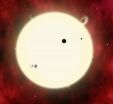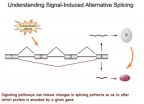(Press-News.org) How do astronomers weigh a star that's trillions of miles away and way too big to fit on a bathroom scale? In most cases they can't, although they can get a best estimate using computer models of stellar structure.
New work by astrophysicist David Kipping says that in special cases, we can weigh a star directly. If the star has a planet, and that planet has a moon, and both of them cross in front of their star, then we can measure their sizes and orbits to learn about the star.
"I often get asked how astronomers weigh stars. We've just added a new technique to our toolbox for that purpose," said Kipping, a predoctoral fellow at the Harvard-Smithsonian Center for Astrophysics.
Astronomers have found more than 90 planets that cross in front of, or transit, their stars. By measuring the amount of starlight that's blocked, they can calculate how big the planet is relative to the star. But they can't know exactly how big the planet is unless they know the actual size of the star. Computer models give a very good estimate but in science, real measurements are best.
Kipping realized that if a transiting planet has a moon big enough for us to see (by also blocking starlight), then the planet-moon-star system could be measured in a way that lets us calculate exactly how large and massive all three bodies are.
"Basically, we measure the orbits of the planet around the star and the moon around the planet. Then through Kepler's Laws of Motion, it's possible to calculate the mass of the star," explained Kipping.
The process isn't easy and requires several steps. By measuring how the star's light dims when planet and moon transit, astronomers learn three key numbers: 1) the orbital periods of the moon and planet, 2) the size of their orbits relative to the star, and 3) the size of planet and moon relative to the star.
Plugging those numbers into Kepler's Third Law yields the density of the star and planet. Since density is mass divided by volume, the relative densities and relative sizes gives the relative masses. Finally, scientists measure the star's wobble due to the planet's gravitational tug, known as the radial velocity. Combining the measured velocity with the relative masses, they can calculate the mass of the star directly.
"If there was no moon, this whole exercise would be impossible," stated Kipping. "No moon means we can't work out the density of the planet, so the whole thing grinds to a halt."
Kipping hasn't put his method into practice yet, since no star is known to have both a planet and moon that transit. However, NASA's Kepler spacecraft should discover several such systems.
"When they're found, we'll be ready to weigh them," said Kipping.
INFORMATION:
How to weigh a star using a moon
2010-10-17
ELSE PRESS RELEASES FROM THIS DATE:
Images shed new light on inflammation
2010-10-17
Calgary, AB - Researchers at the University of Calgary Faculty of Medicine are using an innovative new imaging technique to study how white blood cells (called neutrophils) respond to inflammation, and have revealed new targets to inhibit the response.
When the body is invaded by infection, the immune system counters by generating inflammation with deployment of white blood cells to the site of danger to kill invading bacteria. However, inappropriate inflammation occurs in the absence of infection when tissues are damaged, and this inappropriate response contributes ...
Beauty is in the eye of the beholder the world over
2010-10-17
Western culture is increasingly obsessed with physical appearance and beauty, but vanity is nothing new, nor is it limited to just one culture. Moreover, differences in our perception of physical beauty have an enormous impact on the fashion, cosmetics, and weight control industries, and more recently on aesthetic surgery trends. Understanding how culture and region alter the perception of beauty is therefore not only of anthropological and social interest but underpins multibillion dollar industries across the globe.
According to Anil Mathur of Hofstra University in ...
Gynecologist disputes findings
2010-10-17
(Phoenix, Arizona October 15, 2010) -- An internationally-recognized gynecologic oncologist at St. Joseph's Hospital and Medical Center in Phoenix, Arizona is warning that the results from a long-awaited global study of ovarian cancer should be viewed cautiously.
Published in The Lancet last month, the study reported that women who received early chemotherapy for a recurrence of ovarian cancer did not live longer than those whose treatment is delayed. London-based, The Lancet is one of the world's most respected medical journals.
"While this study is a bold challenge ...
UCSF's Prusiner receives President's National Medal of Science
2010-10-17
UCSF Nobel laureate Stanley B. Prusiner, MD, UCSF professor of neurology and director of the Institute for Neurodegenerative Diseases, today (Oct. 15, 2010) was named to receive the National Medal of Science, the nation's highest honor for science and technology.
Prusiner was among 10 recipients named by President Barack Obama. In addition, three individuals and one team were named as recipients of the National Medal of Technology and Innovation. All of the awardees will receive their medals at a White House ceremony later this year.
The National Medal of Science honors ...
Shifting forms: Penn study shows how variations of same protein affect immune response
2010-10-17
PHILADELPHIA – How a T cell decides to make protein X, Y, or Z can have profound effects for fighting foreign invaders or staving off dire autoimmune reactions. Researchers at the University of Pennsylvania School of Medicine have identified the steps that control how different forms of an immune cell protein called CD45, which is critical for activating the immune system when faced with pathogens, are controlled in the arc of a body's immune response.
The shift between different forms of CD45 helps T cells function properly and also prevents hyperactivity, which could ...
National study identifies range of opportunities to improve engineering education
2010-10-17
America's higher education system is widely regarded to be one of the largest and most flexible systems in the world. Despite this advantage, the U.S. is in danger of being
outpaced by other countries in producing innovative scientists and engineers. Recent
reports by the federal government underscore the challenge faced by the U.S.: science
and engineering students need to be better prepared with the motivation, competence, and
critical thinking skills required to solve problems and generate technological
breakthroughs if the nation is to remain a global economic ...
NJIT professor helps make case in Science for better biodiversity
2010-10-17
In a Policy Forum article in today's issue of Science, a group of leading biodiversity scientists, including NJIT's Daniel Bunker, have argued that targets to be met by 2020 under the Convention on Biological Diversity (CBD) must consider the real value of biodiversity if they are to be attained.
"Ecosystem Services for 2020" outlines how biodiversity can be valued by considering the ecosystem services that biodiversity provides. By incorporating this ecosystem services approach into the CBD targets, signatory nations can better justify and thereby improve biodiversity ...
What did T. rex eat? Each other
2010-10-17
New Haven, Conn.—It turns out that the undisputed king of the dinosaurs, Tyrannosaurus rex, didn't just eat other dinosaurs but also each other. Paleontologists from the United States and Canada have found bite marks on the giants' bones that were made by other T. rex, according to a new study published online Oct. 15 in the journal PLoS ONE.
While searching through dinosaur fossil collections for another study on dinosaur bones with mammal tooth marks, Yale researcher Nick Longrich discovered a bone with especially large gouges in them. Given the age and location of ...
Pre-employ.com welcomes Phillip A. Smith as new company President.
2010-10-17
For more than 15 years Pre-employ.com has long been established as a leader of the background screening industry: This month, the company welcomes Phillip A. Smith—an accomplished professional with extensive industry experience—to the role of President.
"I am looking forward to joining the Pre-employ.com team and to working with its outstanding group of professionals," said Smith. "This is an exciting organization and I expect that we will continue to accomplish great things."
Smith will assume the role of President and will oversee a variety of ongoing initiatives, ...
Bushart Releases New Hawaiian Jewelry Line: Plumeria Nouveau
2010-10-17
Danny Bushart has released his new line of handmade plumeria jewelry in fine sterling silver. The new line, titled Plumeria Nouveau, seeks to capture the essence of Hawaii, something for which the artist has already achieved widespread acclaim.
"The sweet scent of the plumeria lei is one of my first memories of arriving in Hawaii 12 years ago," says Bushart. "I was inspired immediately, and have wanted to design a line devoted to plumeria for years. With the evolution of my art, I discovered that I could now tap into that feeling in a way that I never imagined before."
For ...


